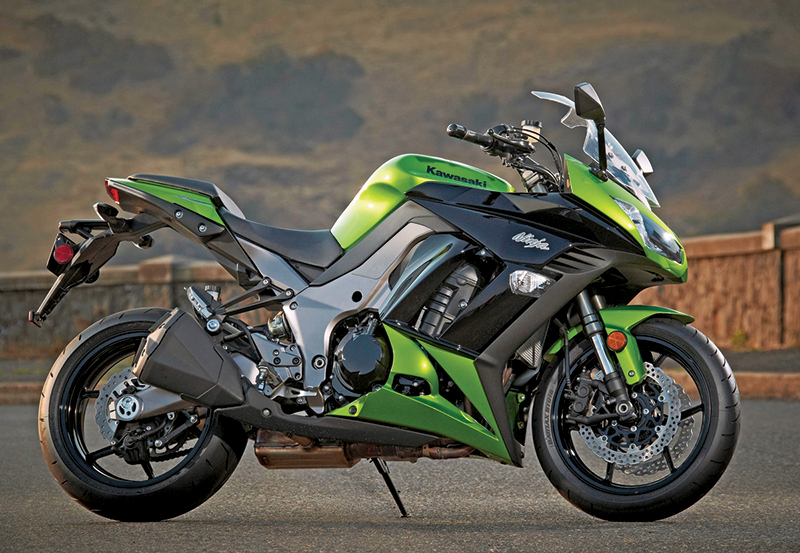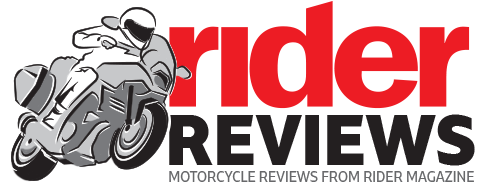2012 Kawasaki Ninja 1000

Road Test Review
Gold is highly valued for its luster, purity and rarity, characteristics that also apply to motorcycles, to varying degrees. Our Kawasaki Ninja 1000 test bike in Candy Lime Green/Ebony certainly has luster, and from a technological point of view, it has purity. No throttle-by-wire, no riding modes, no traction control, no electronically adjustable suspension, not even ABS, though it is available. Rarity is a relative term. Anyone with the requisite cash or credit can buy a Ninja 1000, so ownership does not confer membership in an exclusive club. But it’s a liter-class sportbike built for the street, not the track, and can be outfitted with factory accessory hard saddlebags—a rarity in this segment.
We tested the Ninja 1000 when it debuted in 2011 (Rider, February 2011 and on ridermag.wpengine.com), and we were impressed with its performance as well as its concessions to comfort. The aforementioned saddlebags were on view at the press launch, but they weren’t available for our 2011 test. When Kawasaki offered us a Ninja 1000 decked out with factory touring accessories (see sidebar), we gladly accepted. Within minutes, I had plotted an 1,100-mile test route from our coastal offices in Ventura, California, to the Gold Country of the Sierra Nevada.
Sharing a platform with the naked Z1000, the Ninja 1000 is powered by a purpose-built, liquid-cooled, transverse in-line four that displaces 1,043cc, an engine that combines the performance of a sportbike with the civility of a sport tourer. Dual overhead cams actuate four valves per cylinder and dual counterbalancers keep everything reciprocating smoothly. Vibration is negligible at cruising rpm, but a high-frequency buzz begins to creep through the footpegs, tank and grips as revs increase. Throttle response is flawless, power delivery is linear and torque is broad and generous. On Jett Tuning’s dyno, our 2011 test bike posted peak rear-wheel figures of 125.1 horsepower at 9,900 rpm and 74.4 lb-ft of torque at 8,000 rpm. Horsepower increases smoothly and steadily to a nice 120-plus plateau from 8,700 rpm to the 11,000-rpm redline, and 80 percent of maximum torque is available from 3,800 rpm to redline. Air intake ducts positioned near the rider and an airbox resonator work together to provide a wailing intake howl at higher revs, and the 4-2-prechamber-2 exhaust layout, with stubby dual-tip silencers on both sides of the bike, is tuned just right—loud enough to be exciting without being annoying. Both the brake and clutch lever are adjustable and the transmission shifts seamlessly.
With my gear packed into the saddlebags and seatbag, I steeled myself for the superslab drone across California’s Central Valley, a long, flat expanse shrouded in agricultural haze. Cruising at 70-plus mph, the Ninja 1000 felt smooth and steady, its engine turning about 5,000 rpm. Bar risers position the clip-ons about 4 inches above and 1 inch behind the triple clamp, allowing me to sit up comfortably with minimal weight on my wrists. Although my upper body was comfortable, limited space between the 32.3-inch seat and the footpegs put a sharp bend in my knees, causing them to ache after an hour or so. Pressing a small lever below the instrument panel allows the hinged windscreen to be set to one of three positions that varies pitch over a 20-degree range and height over a 3-inch range. Depending on which position was chosen, wind hit me from mid-torso to just below my chin, but airflow was always smooth with no buffeting or excess noise.
North of Fresno, I began the gradual climb into the foothills of the Sierra Nevada, an impressive mountain range near California’s eastern border. At Oakhurst, I picked up Route 49, known as the Golden Chain Highway because it passes through historic mining towns that sprang up during the California Gold Rush in the mid-1800s, an event that left quite an impression. California is known as the Golden State, its state motto is
“Eureka” and the shape of state highway signs resembles a miner’s spade. A highlight of Route 49 is the 15-mile, freshly paved section between Bear Valley and Coulterville, snaking down to and across the long finger of Lake McClure, and then twisting its way back up into the hills. On those tight, smooth curves, the Ninja 1000 was in its element, clearly demonstrating its handling advantage relative to larger, heavier, longer sport tourers such as Kawasaki’s Concours 14. Sharper steering geometry, a shorter wheelbase and a sprightly curb weight—501 pounds in stock form, 532 pounds as tested—allow the Ninja to carve through corners with precision and confidence. Aggressive lines can be held or adjusted with ease, and when the road straightens out it tracks true and stable.
After running parallel to the Sierra Nevada on Route 49, I turned eastward, exploring narrow back roads that followed the rugged contours of the foothills. Less pristine pavement resulted in a more jarring ride, but the street-oriented Ninja 1000 felt more compliant than what you’d expect from a tautly suspended, track-bred sportbike. A fully adjustable 41mm male-slider fork with 4.7 inches of travel and a preload (ring-and-locknut) and rebound adjustable rear shock with 5.4 inches of travel soaked up cracks, seams and occasional potholes admirably without harshness. As I flipped the Ninja from one side to the other, navigating my way through the nooks and crannies of Stanislaus National Forest, I came to appreciate the bike’s solid feel and its strong, user-friendly brakes. Triple petal rotors are squeezed by Tokico binders, two radial-mount 4-piston calipers up front and a single pin-slide 1-piston caliper out back, and the setup offers precise feel and impressive power.
The first day’s ride allowed me to get to know the Ninja 1000 in a variety of riding conditions. Early to bed, early to rise, I continued my journey with the rising sun on Route 108, climbing steadily from Sonora to Kennedy Meadow, where I emerged from the dense forest and entered the granite grandeur of the High Sierra. Pines gave way to autumn-colored aspens, and fast sweepers gave way to hairpins, sharp dips and grades as steep as 26 percent. I paused at Sonora Pass (9,624 feet), the second-highest paved pass in the Sierra Nevada. A light covering of snow blanketed the 11,000-foot peaks that towered above, a reminder that this road would soon be closed for the winter.
After plunging down the much steeper eastern face of the mountains, Route 108 dead-ends at U.S. 395, where I turned south, riding past Mono Lake toward Lee Vining. Westbound Route 120 quickly ascends 3,000 feet as it approaches Tioga Pass (9,945 feet), the highest paved pass in the Sierra Nevada and the western portal for Yosemite National Park, considered by John Muir to be “the grandest of all the special temples of Nature I was ever permitted to enter.” Speed limits of 35-45 mph force you to slow down and take in the scenery, though stops at places like Tunnel View or Olmstead Point are the best way to enjoy the full spectacle from the road.
As the sun sank low, I exited Yosemite on Route 140, hugging the Merced River and descending to Mariposa, a quaint mining town where I spent my second night on the road. Another long ride across the Central Valley took me toward the coast and eventually home. Racking up 1,100 miles in three days on a sportbike might suggest that I’m a glutton for punishment, but that isn’t the case. My only complaint about comfort is the cramped legroom, and my 34-inch inseam certainly plays a role. Those with shorter legs may find the legroom adequate since the footpegs aren’t as high or as far back as those on most sportbikes.
Two other issues are more bothersome, one that plagued me constantly and one that revealed itself back at the office. The multifunction LCD display that’s paired with the analog tachometer was often obscured by glare from the sun. I could usually make out the large speed readout and fuel gauge, but I struggled to read the tripmeter and clock—doing so distracted me from the road. Furthermore, the low-fuel indicator flashes the last bar of the fuel gauge and a small fuel pump symbol, both of which are monochrome like the rest of the LCD display and therefore don’t stand out, especially given the glare. The other issue is that the saddlebags leaked, having failed the hose test in our parking lot even though the lids appear to seal well and there’s a rubber gasket where the two halves come together.
For riders who want the look and feel of a liter-class sportbike, who want the power and the handling and light weight but don’t want or need today’s electronic aids like riding modes and traction control, and who also want to hit the road for a long weekend, the Kawasaki Ninja 1000 with factory touring accessories provides a rare opportunity. The 5-gallon steel fuel tank allows the use of a magnetic tankbag, and with a mix of riding provides decent touring range. I averaged 38.5 mpg (192-mile range) but got as high as 42.5 mpg (213-mile range). For 2013, the Ninja 1000 returns unchanged except for a small price increase ($11,399, add $700 for ABS) and new colors.
